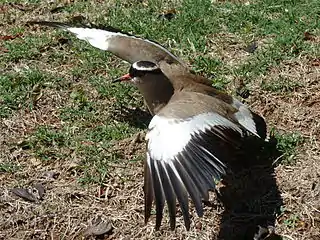Crowned lapwing
The crowned lapwing (Vanellus coronatus), or crowned plover, is a bird of the lapwing subfamily that occurs contiguously from the Red Sea coast of Somalia to southern and southwestern Africa. It is an adaptable and numerous species, with bold and noisy habits. It is related to the more localized black-winged and Senegal lapwings, with which it shares some plumage characteristics.
| Crowned lapwing | |
|---|---|
%252C_Santuario_de_Rinocerontes_Khama%252C_Botsuana%252C_2018-08-02%252C_DD_22.jpg.webp) | |
| In Mikumi National Park, Tanzania | |
| Scientific classification | |
| Kingdom: | Animalia |
| Phylum: | Chordata |
| Class: | Aves |
| Order: | Charadriiformes |
| Family: | Charadriidae |
| Genus: | Vanellus |
| Species: | V. coronatus |
| Binomial name | |
| Vanellus coronatus (Boddaert, 1783) | |
| Synonyms | |
|
Charadrius coronatus (Boddaert, 1783) | |
Taxonomy
The crowned lapwing was described by the French polymath Georges-Louis Leclerc, Comte de Buffon in 1781 in his Histoire Naturelle des Oiseaux from a specimen collected in the Cape of Good Hope region of South Africa.[2] The bird was also illustrated in a hand-coloured plate engraved by François-Nicolas Martinet in the Planches Enluminées D'Histoire Naturelle which was produced under the supervision of Edme-Louis Daubenton to accompany Buffon's text.[3] Neither the plate caption nor Buffon's description included a scientific name but in 1783 the Dutch naturalist Pieter Boddaert coined the binomial name Charadrius coronatus in his catalogue of the Planches Enluminées.[4] The crowned lapwing is now placed in the genus Vanellus that was erected by the French zoologist Mathurin Jacques Brisson in 1760.[5][6] The generic name Vanellus is the Medieval Latin for a "lapwing". It is a diminutive of the Latin vanus meaning "winnowing" or "fan". The specific epithet coronatus is Latin for "crowned".[7]
Three subspecies are recognised:[6]
Description

The crowned lapwing is easily recognized by its combination of brown and white colours, with most tellingly, a black crown intersected by an annular white halo. Adults are noisy and conspicuous.
Males measure on average 3% larger than females. Juveniles are dull versions of adults, vermiculated on the wings and mantle, the legs yellowy rather than red and the bill lacking the red base.
Habitat and numbers
Crowned lapwings prefer short, dry grassland which may be overgrazed or burnt, but avoid mountains. In higher-rainfall areas such as parts of Zambia and Zimbabwe, they occur mainly as dry-season visitors. In dry regions of northern Botswana, however, they are attracted in large numbers when good rainfall occurs. In southern Africa their highest concentrations are to be found in the dry central Kalahari region.
Although generally outnumbered by blacksmith lapwings, they are the most widespread and locally the most numerous lapwing species in their area of distribution. Their numbers have increased in the latter part of the 20th century after benefiting from a range of human activities. They live up to 20 years.
The crowned lapwing is one of the species to which the Agreement on the Conservation of African-Eurasian Migratory Waterbirds (AEWA) applies.
Behaviour
Crowned lapwings and the more localized black-winged lapwings sometimes associate and do not show mutual aggression, even within breeding territories. Different crowned lapwing males do however posture aggressively when nesting territories are established. The loser in an encounter assumes a special posture to signal his defeat.
Bare-part colours of males brighten in the breeding season. Different types of display flights lure the female to the defended territory. A female accepting the male and territory will follow the male during his display flight. Mates may be retained for life. Egg-laying is timed to precede the rainy season and most incubating is done by the female. The male assists only on hot days, when he either incubates or shades the nest.
Food
Their diet consists of a variety of insects, but termites form an important component.

Adult defending its nest %252C_nes%252C_Pretoria.jpg.webp)
Clutch on matching plant debris 
A juvenile in the Zulu Nyala Game Reserve, South Africa _in_flight.jpg.webp)
Crowned lapwings in flight
References
- BirdLife International (2012). "Vanellus coronatus". IUCN Red List of Threatened Species. 2012. Retrieved 26 November 2013.CS1 maint: ref=harv (link)
- Buffon, Georges-Louis Leclerc de (1781). "Le pluvier couronné". Histoire Naturelle des Oiseaux (in French). Volume 15. Paris: De L'Imprimerie Royale. p. 159.
- Buffon, Georges-Louis Leclerc de; Martinet, François-Nicolas; Daubenton, Edme-Louis; Daubenton, Louis-Jean-Marie (1765–1783). "Pluvier, du Cap de Bonne-Esperance". Planches Enluminées D'Histoire Naturelle. Volume 8. Paris: De L'Imprimerie Royale. Plate 800.
- Boddaert, Pieter (1783). Table des planches enluminéez d'histoire naturelle de M. D'Aubenton : avec les denominations de M.M. de Buffon, Brisson, Edwards, Linnaeus et Latham, precedé d'une notice des principaux ouvrages zoologiques enluminés (in French). Utrecht. p. 49, Number 800.
- Brisson, Mathurin Jacques (1760). Ornithologie, ou, Méthode Contenant la Division des Oiseaux en Ordres, Sections, Genres, Especes & leurs Variétés (in French and Latin). Paris: Jean-Baptiste Bauche. Vol. 1, p. 48, Vol. 5, p. 94.
- Gill, Frank; Donsker, David, eds. (2019). "Grebes, flamingos, buttonquail, plovers, painted-snipes, jacanas, plains-wanderer, seedsnipes". World Bird List Version 9.2. International Ornithologists' Union. Retrieved 18 July 2019.
- Jobling, James A. (2010). The Helm Dictionary of Scientific Bird Names. London: Christopher Helm. pp. 118, 398. ISBN 978-1-4081-2501-4.
- Hockey P.A.R., Douie C. 1995. Waders of southern Africa
- Maclean G.L. 1984. Roberts' Birds of Southern Africa. Fifth edition
- Marchant J., Prater T., Hayman P. 1986. Shorebirds: An identification guide
- Sinclair I., Ryan P. 2003. Birds of Africa south of the Sahara
- Ward D., Crowned Plover. In: The atlas of southern African birds. Vol. 1: Non-passerines
External links
| Wikimedia Commons has media related to Vanellus coronatus. |
- Crowned lapwing - Species text in The Atlas of Southern African Birds.
